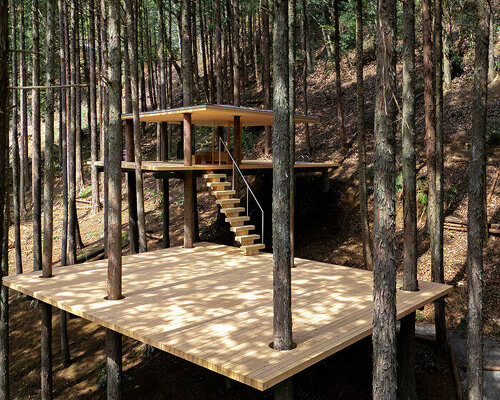daichi weaves cabin into the japanese forest
Amid the wooded hills of Sagamihara City in Kanagawa, Japan, DAICHI inserts Tree Sauna, a structure designed to be both a sauna and a sleeping shelter. This small 100-square-meter building seems to grow from the surrounding forest, and, unlike most architecture, conforms to its natural context, asking for permission rather than staking a claim.
The architecture emerges from what DAICHI principal Makoto Tanijiri calls the ‘in-between’. ‘Between the city and nature, between people and objects, between inside and outside, or between function and feeling,’ he notes. ‘I have come to see these spaces not as mere gaps or neutral zones, but as creative frontiers—places where sensitivity and imagination can take root.’
Built without disturbing existing trees, the structure is composed in harmony with the forest, allowing it to warp, lean, or even break in response to the terrain, embracing distortion as a reflection of nature’s rhythms. ‘This distortion is not a designer’s manipulation but the result of a dialogue with nature,’ Tanijiri shares. ‘It breathes in ways that overly polished spaces never could.’
all images courtesy of DAICHI
Tree Sauna is designed for trees, wind, and people
Creative development company DAICHI intentionally introduces inconvenience as an architectural principle with this project, free of fixed programs and engineered efficiencies. Tree Sauna’s safety isn’t guaranteed, its purpose is unclear, and how people use it is left open. ‘There is a concept known as ”benefits of inconvenience” — the idea that, in seeking convenience, we’ve lost certain instincts: to feel, to imagine, to move with our hands,’ Tanijiri explains. ‘By revisiting inconvenience, we reclaim those primal abilities.’
Set on a forested site with a footprint of just 99 square meters, Tree Sauna is entirely designed in-house by DAICHI, covering everything from architecture to structure and mechanical systems. Its compact form is a way to prompt larger questions about space, use, and presence. The structure is shaped to allow in elements like time, sound, humidity, and uncertainty, drawing people into the forest. ‘What is architecture, really?’ the architect asks. ‘Is it something built only for humans? Or should it be something shared with the trees, the wind, and the birds?’
DAICHI inserts Tree Sauna amid the wooded hills of Sagamihara City in Kanagawa, Japan
this small 100-square-meter building seems to grow from the surrounding forest
the architecture emerges from what DAICHI principal Makoto Tanijiri calls the ‘in-between’
asking for permission rather than staking a claim
built without disturbing existing trees
the Tree Sauna warps, leans, and even breaks in response to the terrain
the design embraces distortion as a reflection of nature’s rhythms
DAICHI intentionally introduces inconvenience as an architectural principle
free of fixed programs and engineered efficiencies
Tree Sauna is entirely designed in-house by DAICHI
the structure is shaped to allow in elements like time, sound, humidity, and uncertainty
project info:
name: Tree Sauna
architect: DAICHI Inc. | @daichi_nature
location: Sagamihara City, Kanagawa, Japan
site area: 426 square meters
building footprint: 99 square meters
total floor area: 100.4 square meters
principal architect: Makoto Tanijiri | @tanijirimakoto
construction: Tonkachi Drills Inc.
The post tree trunks pierce through sauna shelter by DAICHI in japanese forest appeared first on designboom | architecture & design magazine.

